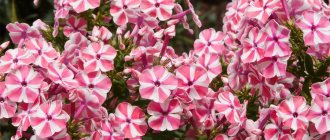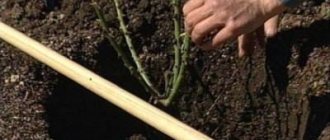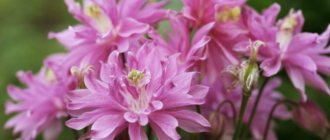Vegetable growing » Cabbage
1
1591
Article rating
Kira Stoletova
Hare cabbage is a perennial plant belonging to the Crassulaceae genus. It grows on sandy soils. You can find cabbage near bodies of water, along roads, where it merges with bushes.
Medicinal properties of hare cabbage
Characteristics of hare cabbage
Hare cabbage has a tuberous root system. The roots of such a plant are quite thick and dense, which makes it much more difficult to pull the bush out of the ground. The plant is characterized by a tall, straight stem that is cylindrical in shape. The height of the bush can reach 60 cm. Hare cabbage looks like an ordinary bush.
Usually hare cabbage has round or oval leaves of large sizes. There is no roughness observed on their surface. They are completely covered with a thick layer of wax, and on their edges there are small teeth.
Rabbit cabbage has small flowers. There are inflorescences of pink or yellow shades. They consist of several flowers and are located in the upper part of the plant. Flowers are multi-leafed. The plant blooms from early July to August. Hare cabbage is most often found in Europe.
The plant has beneficial medicinal properties.
Botanical description of common wood sorrel
The height of the plant does not exceed 12 centimeters. Common wood sorrel is a perennial flowering herb with a superficial creeping rhizome. Tuberous growths or bulbs form on the rhizome itself. An interesting feature is that the roots of sorrel are infected with fungi that penetrate the root cells and promote its branching.
The leaf blades have long petioles with three soft petals. The leaves are heart-shaped with entire edges. At night or when adverse weather conditions occur, they droop and fold. The high content of oxalic acid gives the foliage a sour taste.
Peduncles are long, up to 10 centimeters. The flowering process begins in late May - early June. The buds are single, white with pink veins and a yellow base. The petals are oval with slight pubescence at the edge. The diameter of the flowers is about 2 centimeters. The fruit of the sorrel is represented by a five-locular capsule, which opens after the seeds ripen by breaking the nests.
Varieties of cabbage
There are several types of sorrel (another name for cabbage).
- Purple sorrel is characterized by a pleasant lilac color. The tree grows up to 1 m in height. This garden crop is often grown at home. Caring for it involves timely watering (once a week).
- Wood sorrel has characteristics similar to another variety - common sedum. The difference between them is that the forest variety can only grow in wild conditions (hence the name). The flower of this species is not very large.
- The red variety is more common in Siberia. The height of the bush reaches 60 cm. Flowers are presented in red or pink tones.
- The common sedum is a houseplant that can be grown at home. The best growth is observed in the wild. The height of the bush is about 70 cm. The flowers have a purple tint.
Care requirements
Now about what the indoor oxalis flower will require from gardeners - care at home is not complicated, suitable for beginners. This species loves fresh air, so it is necessary to organize regular ventilation of the room, especially in the summer.
Location and lighting
Purple indoor oxalis can grow in the shade when cared for at home. A suitable place for it would be a western, southwestern or eastern window sill. If there is more diffused light, the brightness of the leaves will increase and there will be more flower stalks.
It is advisable to avoid exposure to direct sunlight to avoid causing burns, especially in red-leaved and purple species. The plant has delicate leaves, so cold drafts are also unacceptable.
Video: Caring for oxalis at home
Temperature
In spring and summer, the suitable temperature range for hare cabbage is 20 to 25 degrees. In winter, the pot must be removed to a cool room so that the flower forms buds for the development of flower stalks. If the plant is kept warm all the time, it will not bloom. The same goes for seeds - they require stratification before sowing.
The dormant period when growing and caring for wood sorrel at home lasts only 6 weeks. A sign of the end of the growing season is massive falling of leaves and drooping stems. If they are dry, they are cut off and the pot is transferred to a cool room with a temperature of 6 to 12 degrees.
Humidity
For oxalis triangularis - triangular hare cabbage - normal room humidity is suitable. This is approximately 65%. If the air is drier, it is recommended to install it near a container with water for evaporation. It is advisable to have a humidity sensor in the house to monitor the indicators
It is also important for people's health
In winter, an additional source of moisture is not needed.
Watering
Oxalis loves water, but moisture should not be allowed to stagnate in the root area. This leads to rotting of the bulbs and death of the root system. In hot weather, water abundantly; before the dormant period, reduce the amount and volume of water. In winter, you need to keep the soil moist and not allow it to dry out.
Spraying daily is necessary if the summer temperature rises above 25 degrees. To avoid damaging the leaves, use boiled, settled water without impurities of calcium and magnesium salts. Soft rainwater will do.
You cannot spray the plant in a cold room in winter.
Soil and pot
Since the rhizome is located in the upper part of the soil, sorrel requires a wide but shallow pot for rapid growth. This way you can get a big beautiful bush.
Hare cabbage is undemanding in terms of soil composition, but it is desirable that the soil be loose - in such conditions the bulbs develop faster.
For abundant flowering, you need organic matter in the form of natural additives - manure, droppings, ash solution. Plant components are food for soil microorganisms that synthesize humus, the main indicator of fertility. Humus affects the looseness and moisture capacity of the soil.
Feeding
Complex mineral fertilizers are used from the beginning of February, since at this time the dormant period of hare cabbage ends. For the first time, apply 1/4 of the dose to stimulate vegetation. Then every 2 weeks it is necessary to water with a nutrient solution half as much as indicated in the instructions.
In the first half of spring, it is necessary to give fertilizers with equal amounts of nitrogen, potassium and phosphorus, then switch to potassium-phosphorus mixtures. If you overdo it with nitrogen, leaves and shoots will grow, but flowering will not occur.
Useful properties of hare cabbage
Sedum or hare cabbage (these are 2 names for the same plant) is characterized by excellent healing properties for the human body.
A plant such as hare cabbage contains vitamins C, tannins, carotene, medicinal salts, various natural acids and flavonoids.
Product benefits:
- helps get rid of pain;
- tones the entire body (after illness or overwork);
- allows wounds to heal as quickly as possible;
- helps stop bleeding;
- thanks to the use of leaves, you can quickly cleanse the skin of various inflammations (pimples or blackheads);
- helps get rid of allergies, which manifest themselves in the form of skin rashes;
- Using the juice will normalize the functioning of the heart and central nervous system.
Hare cabbage, thanks to its rich beneficial composition, is used in folk medicine. Tinctures are used to cure diseases of the gastrointestinal tract (duodenum, ulcers or gastritis), hormonal balance (menstrual irregularities) or diseases of the respiratory system (bronchitis, asthma or pneumonia).
Ointments prepared from finely chopped leaves are used for external treatment. They are used in the fight against osteochondrosis, radiculitis, or various cuts and burns. Rabbit cabbage rubs help normalize the flow of breast milk. This method is especially effective in case of stagnation. Using a decoction of this herb allows you to remove waste and toxins from the body.
Harvesting cabbage
Cabbage is used in folk medicine
In folk medicine there are recipes that use both the above-ground part of the crop and the root.
- The grass should be collected and dried at the moment when the bush just begins to bloom. It is better to collect flowers and leaves in sunny and dry weather, otherwise there is a risk of a decrease in beneficial properties.
- It is better to dig up and collect the roots in early September, when they absorb the maximum amount of nutrients from the soil.
The beneficial properties of hare cabbage are maximally manifested only if the drying is carried out correctly. Typically, it is recommended to dry the green part of the plant in large rooms with good ventilation. Before you start drying the roots, it is important to clear them of soil and top layer, cut them into small slices and hang them on a barn or basement window.
Caustic
Description
Sedum is a miniature ground cover plant, often buried under the snow in winter with live shoots and leaves.
The rhizome is branched, numerous stems more than 15 centimeters long, do not rise above the soil surface, the leaves are small, sessile, thick, bright yellow flowers have the shape of a five-pointed star, collected in loose inflorescences.
Application
Traditional healers knew that sedum should be used with caution, it is poisonous .
The juice was used to remove warts and calluses; if it came into contact with the skin, it could cause a burn.
Infusions and decoctions of medicinal sedum have a strong diuretic, anti-inflammatory, and restorative effect; malaria, epilepsy, and atherosclerosis have been successfully treated with sedum.
Side effects
This type of sedum cannot be used to treat children, pregnant and nursing mothers ; its use may cause nausea, vomiting, intestinal spasms, and difficulty breathing.
The chemical composition of sedum has been well studied; it includes alkaloids, glycosides, saponins, organic acids, resins, and vitamins.
Despite its wide range of applications, due to its high toxicity, it is not currently used in traditional medicine , but is still quite often used by traditional healers.
Hare cabbage infusion
Hare cabbage is often used as a tincture. There are several common recipes.
- About 50 g of crushed leaves should be poured into 500 ml of boiled water. This mixture should be placed in a cool, dark room for 5 hours. After the specified time, the substance is filtered through a sieve or gauze and poured into a clean container. You need to take the tincture 3 times a day, 30 ml before meals. This infusion is believed to be an effective remedy against gastritis, diarrhea, infertility, fatigue or kidney failure.
- You need to mix 25 g of the green part of the grass with 25 g of the root system. This mixture must be poured with 500 ml of boiled water and left in a thermal container for 5-6 hours. This tincture should be used to lubricate sore areas with sore throat, burns, and cuts. This infusion also actively helps get rid of warts, ulcers or calluses.
Contraindications
You should not use products made from hare cabbage if you have allergic reactions to the substances it contains - ascorbic acid, starch, glycosides. The appearance of a small reddish rash all over the body after taking a decoction and solution of sorrel orally is an absolute contraindication for food use.
Use with caution:
- in the presence of reflux disease and increased stomach acidity;
- in children under 10 years of age.
Hare cabbage decoction
Sometimes hare cabbage is used in the form of a decoction. To prepare it you will need 20 g of dry crushed leaves. They are added to 200 ml of warm water, and the mixture is placed on the stove.
You need to keep the mixture on the fire for no more than 10 minutes, otherwise all the beneficial properties will be destroyed by high temperatures. After the specified time, remove the dishes from the heat and place them in a dark place until they cool completely. After this, it is poured into a clean container. You should consume about 20 ml of the drug, 2-3 times a day. This decoction will be effective in the fight against kidney diseases.
Problems during cultivation
Why doesn't it bloom?
Oxalis stops blooming if it overwinters without a dormant period - this leads to depletion of the plant. In addition, excess fertilizer has a negative effect on flowering. It is necessary to reconsider the feeding regime and give the flower a rest by placing it in a cool room.
Diseases
Due to excessive watering and stagnation of moisture in the soil, root rot can develop. Oxalis should be transplanted into dried soil, remove all parts of the plant affected by the disease and reduce watering. Fundazol is also used for treatment.
Pests
Oxalis is rarely affected by pests, but from time to time spider mites and aphids may appear on the leaves of the plant.
To get rid of these insects, you need to prepare a soap solution by diluting 1 tablespoon of soap in 1 glass of water and spray the sorrel with it.
In case of severe damage, it is necessary to use insecticides - “Fitoverm”, “Akarin” or “Aktellik”.
Hare cabbage juice
The green part of the cabbage should be thoroughly washed under running water and pour boiling water over it, leave for 20 minutes. After this, you should make porridge (using a meat grinder or juicer). The resulting juice is mixed with clean water in a ratio of 1:2.
Every day it is recommended to take 1 tbsp. l. juice on an empty stomach, 3-4 times a day. The product is used for external treatment. If there is a wound or inflammation on the face, then a cotton pad should be soaked in juice and applied to the site of inflammation or injury.
Rules of care
Hare Cabbage is easy to care for and does not have any special requirements for growing conditions.
Watering
It is better to water Hare Cabbage rarely, but watering should be sufficient, abundant and regular. Watering for Hare Cabbage requires moderate watering. In spring and summer this means regular watering with a small amount of water. The soil should always be slightly moist. In early autumn, watering is reduced by half, and by cold weather it is stopped completely. In case of lack of moisture, the plant begins to use its own leaves, and therefore withers and loses its former decorative effect.
Climate
The plant must develop in natural conditions of a temperate climate. The temperature in summer should be between 18-24 degrees. The place should be illuminated, but without scorching sun rays. Almost any soil will do. It can be black soil or sand with the addition of peat. It also grows in rocky places. The ground part will become more luxuriant if you fertilize the flower with liquid organic fertilizers and ash from time to time. Sedum is frost-resistant, so it can easily survive the winter without special preparation or shelter.
In winter, the above-ground part does not need to be removed, then the dead wood will decorate the flowerbed even in the cold season.
How to plant correctly
The plant can be planted in spring or autumn. The first step is to choose a suitable place in the garden. Sedum loves sun and moisture in moderation. The best place will be an open, unfenced area.
Hare cabbage in bloom
Humus and soil are added to the shallow planting hole. The seedling is placed in it, covered with the remaining soil and watered well with water and fertilizer. Flowering may appear already in the first year of planting if it was planted in the spring. From time to time, the plant must be loosened with gentle movements so as not to damage the roots, which are located very close to the surface of the earth.
Reproduction methods
Oxalis is propagated in three ways. This is by seeds, cuttings and dividing the bush. Both methods are considered simple and fast.
- Seeds are sown immediately in open ground in early spring or before winter in small boxes, which are covered and left for the winter in a cool place, for example in a basement. And in spring the sprouts are planted in the ground.
- Gardeners use dividing the bush in order to propagate and rejuvenate the old bush, since all sedums grow in one place for no more than 5 years. An adult bush is dug up and divided into several parts. These parts are planted in pre-prepared holes and watered with water.
- Propagation by cuttings. This method is considered the most convenient among specialists. At the very beginning, it is worth preparing a place for planting in open ground. Then the cut lower cuttings of the mother plant are placed in the ground, sprinkled with garden soil and sand and watered. After a few days they form a root.
After each work done with the plant, you must wash your hands thoroughly, as the juice causes an allergic reaction and burns.
Rabbit cabbage flower
A decoction prepared from the flowers of this plant perfectly helps to cope with general fatigue of the body and improves the tone of the whole body. This is an effective remedy for improving the immune system. The decoction should be consumed 3 times a day, 30 ml. It's better to do this while eating.
Fresh flowers are edible and quite tasty. They help restore the body after a long and complex illness. It has an analgesic and healing effect if applied to a wound or burn.
How it is used in folk medicine
Large sedum or young is a type of plant located in the northern regions of the country. It has thicker stems, fleshy leaves, and bright pink or pale purple flowers.
Sedum has all the healing properties of wood sorrel in a more pronounced form. The period of its active growth and flowering occurs in July-August, so those wishing to obtain the drug from this plant must collect it during these months.
Sedum or young is used in the form of infusions, decoctions, compresses for the treatment of diseases of the musculoskeletal system, digestive and urinary organs.
Plant propagation by cuttings and dividing the bush
Sedum with purple leaves, as with green ones, is propagated not only by seed, but also by vegetative means, which is easier to perform and allows you to preserve varietal characteristics.
Cuttings
A popular technique in which:
- With the arrival of autumn, several shoots are cut from an adult plant and placed in a vase.
- During the autumn-winter period, the water is systematically renewed.
- By spring, the vase will contain a whole bunch of rooted cuttings, ready for planting in open ground.
Rooting can also be carried out directly in a permanent place of growth, which will be cleared of weeds and fertilized. The cuttings are buried at an angle into garden soil mixed with sand and lightly pressed down. The survival rate ranges from 70 to 100%.
Watch this video on YouTube
If there is a four-year-old bush in the garden, the gardener can divide it. In the spring, the rhizome is removed, cleared of soil residues and divided into parts, each of which must have roots and growth buds. The cuttings are air-dried for several hours, and then seated in prepared holes.
What is used
Healing tinctures can be prepared from various parts of sedum.
Flowers
When creating medicines, the young flower of the plant is often used. It has hemostatic and analgesic properties. The flowers contain alkaloids and acids that can strengthen nerve fibers. Therefore, medicinal tinctures can be prepared from them to calm the nervous system. In addition, these decoctions improve blood circulation, help lower blood pressure and eliminate headaches.
Leaves
If a person is faced with respiratory diseases or a cold, decoctions of green leaves are used. They contain a lot of vitamin C, which strengthens the immune system and prevents the further development of colds. The leaves also contain trace elements that promote expectoration of mucus and relieve inflammation in the nasopharynx.











